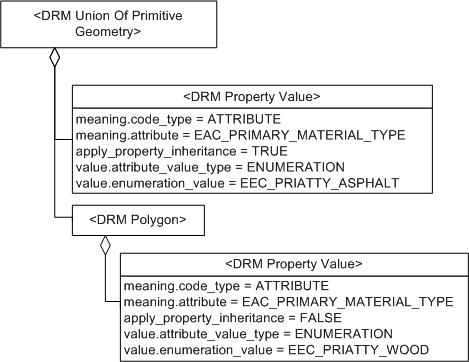Property
|
Description
|
|
Class
|
|
|
Superclass
|
|
|
Subclass
|
|
|
Definition
|
An instance of this DRM class specifies a property of the attributed
DRM object and its value in terms of
-
its meaning (specified using an EAC,
5.2.7.23 Index_Code, or
5.2.7.54 Variable_Code),
-
its unit of measurement (such as metres),
-
and its data storage type (such as
5.2.3.8 Integer).
The value field
specifies the value of the given property.
|
|
Class diagram
|
Figure 6.251 —
DRM_Property_Value
|
|
Inherited field elements
|
|
|
Field elements
|
|
|
Default field values
|
Default field values for DRM_Property_Value
|
Associated to (one-way) (inherited) |
|
Associated to (one-way) |
|
Associated by (one-way) (inherited) |
|
Associated by (one-way) |
|
Associated with (two-way) (inherited) |
|
Associated with (two-way) |
|
Composed of (two-way) (inherited) |
|
Composed of (two-way) |
|
Composed of (two-way metadata) (inherited) |
|
Composed of (two-way metadata) |
|
Component of (two-way) (inherited) |
|
Component of (two-way) |
|
|
Constraints
|
|
|
Clarifications
|
None.
|
|
Example(s)
|
The <DRM Property Value> instances of a representation of a lake
might include the EAC_SURFACE_MATERIAL_TYPE of the lake.
Consider the man-made materials that can be found on any surface,
such as cloth, carpet, asphalt, silk, metal, and natural materials,
such as wood. To specify the material making up a wooden wall
represented by a <DRM Polygon> instance, the
data provider represents it as depicted in Figure 6.252.

Figure 6.252 — <DRM Property Value> example
Consider a <DRM Areal Feature> instance representing
a surface covered with vegetation. To specify the type of vegetation,
the data provider gave it a <DRM Property Value>
component with a meaning of
EAC_VEGETATION_TYPE,
and the value specifying the exact type of vegetation.
Consider a <DRM Areal Feature> instance labeled as
“Red Field”, because the surface represented has clay soil
present. To describe the soil composition at some point or for some
surface, <DRM Property Value> instances are
used, so a <DRM Property Value> instance of the appropriate
attribute is attached to the <DRM Areal Feature> instance.
Consider acoustic response (that is, changes to characteristics of
objects in response to acoustic stimuli) such as the resonant
frequency of a plate, response (such as echo, phase shift, absorption,
diffraction), or frequency.
Consider electromagnetic emission, that is, the emission
characteristics of a geometric object or feature, including
the electromagnetic wavelengths, amplitudes, and directionality.
Examples include
- The thermal signature of a rock at noon is described by its
electromagnetic emission.
- The headlight of a truck.
Consider electromagnetic response (that is, changes to
characteristics of objects in response to electromagnetic stimuli).
Some examples of
such properties include reflective and specular characteristics of a
surface.
Consider hydrology (that is, an attribute describing some aspect of
the flow of water at a location or on a surface). For the
<DRM Polygon> instances that represent Salmon Creek,
an example hydrology property represented by
<DRM Property Value> instances is the average
speed of currents in the stream bed.
<DRM Property Value> instances can provide
metrics or measurements that relate to scalar properties, such as
the elevation at a particular location.
|
